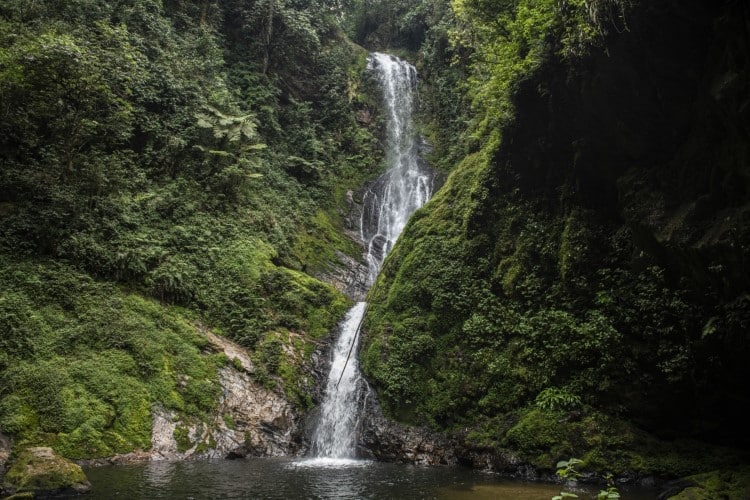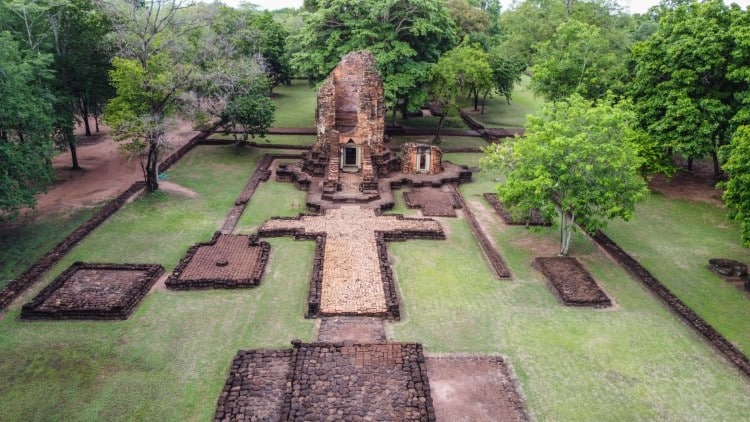
Waterfall in Nyungwe National Park, Rwanda. (Photo: G.R. Vande weghe via UNESCO (CC Attribution-ShareAlike 3.0 IGO)
This year, UNESCO has added 42 new sites to the UNESCO World Heritage list, bringing the total up to 1,199 landmarks across 168 countries. Selected for their historical or cultural significance, these sites will now benefit from the highest level of cultural protection, as well as access to financial assistance from UNESCO.
2023’s selections include 33 cultural sites and nine natural sites. Thanks to five new inscribed sites, Africa has now passed a milestone. The continent is now home to 100 World Heritage Sites, and countries like Rwanda saw themselves added to the list for the first time. With the inclusion of Nyungwe National Park and the genocide memorial sites at Nyamata, Murambi, Gisozi, and Bisesero, the East African nation has two sites inscribed on the list.
In addition to adding new during its session, the World Heritage Committee also makes close evaluations of all World Heritage monuments to ensure their preservation. Following an ambitious restoration project, Uganda’s Tombs of the Buganda Kings at Kasubi was removed from the World Heritage in Danger list. Unfortunately, two sites in Ukraine—Saint Sophia’s Cathedral and complex of monastic and Lavra buildings in Kyiv-Pechersk and the ensemble of the historic center in Lviv—were added to the list due to the risk of shelling. Inclusion in the list will open the doors to critical technical and financial support for these sites at risk.
Check out some of the incredible sites added to this year’s list and explore the full list on UNESCO’s website.
Here are 6 of the 42 exceptional sites added to the UNESCO World Heritage list.
Gaya Tumuli (Republic of Korea)

Gaya Tumuli, Republic of Korea (Photo: Seo Heun Kang via UNESCO (Nomination File (non exclusive cession of rights: yes))
This serial property includes archaeological cemetery sites with burial mounds attributed to the Gaya Confederacy, which developed in the southern part of the Korean Peninsula from the 1st to the 6th century CE. Through their geographical distribution and landscape characteristics, types of burials, and grave goods, the cemeteries attest to the distinctive Gaya political system in which polities existed as autonomous political equals while sharing cultural commonalities. The introduction of new forms of tombs and the intensification of the spatial hierarchy in the tumuli sites reflect the structural changes experienced by Gaya society during its history. (Description via UNESCO)
The Ancient Town of Si Thep and its Associated Dvaravati Monuments (Thailand)

The Ancient Town of Si Thep and its Associated Dvaravati Monuments, Thailand (Photo: The Fine Arts Department via UNESCO (Nomination File (non exclusive cession of rights: yes))
This massive complex includes an Inner and Outer Town surrounded by moats, the massive Khao Klang Nok ancient monument, and the Khao Thamorrat Cave ancient monument. Together these sites represent the architecture, artistic traditions and religious diversity of the Dvaravati Empire that thrived in Central Thailand from the 6th to the 10th centuries, demonstrating the influences from India. The local adaptation of these traditions resulted in a distinctive artistic tradition known as the Si Thep School of Art which later influenced other civilizations in Southeast Asia. (Description via UNESCO)
Winter Deserts of Turan (Kazakhstan, Turkmenistan, Uzbekistan)

Cold Winter Deserts of Turan, Kazakhstan, Turkmenistan, Uzbekistan (Photo: O. Kugaev via UNESCO (Nomination File (non exclusive cession of rights: yes))
This transnational property comprises fourteen component parts found across arid areas of Central Asia’s temperate zone between the Caspian Sea and the Turanian high mountains. The area is subject to extreme climatic conditions with very cold winters and hot summers and boasts an exceptionally diverse flora and fauna that has adapted to the harsh conditions. The property also represents a considerable diversity of desert ecosystems, spanning a distance of more than 1,500 kilometers from East to West. Each of the component parts complements the others in terms of biodiversity, desert types, and ongoing ecological processes.
(Description via UNESCO)
National Archaeological Park Tak’alik Ab’aj (Guatemala)

National Archaeological Park Tak’alik Ab’aj, Guatemala (Photo: National Archaeological Park Tak’alik Ab’aj via UNESCO (Nomination File (non exclusive cession of rights: yes))
Tak’alik Ab’aj is an archaeological site located on the Pacific Coast of Guatemala. Its 1,700-year history spans a period that saw the transition from the Olmec civilization to the emergence of Early Mayan culture. Tak’alik Ab’aj had a primary role in this transition, in part because it was vital to the long-distance trade route that connected the Isthmus of Tehuantepec in today’s Mexico to present-day El Salvador. Ideas and customs were shared extensively along this route. Sacred spaces and buildings were laid out according to cosmological principles, and innovative water management systems, ceramics, and lapidary art can be found. Today, Indigenous groups of different affiliations still consider the site a sacred place and visit it to perform rituals.
(Description via UNESCO)
Eisinga Planetarium in Franeker (Netherlands)

Eisinga Planetarium in Franeker, Netherlands. (Photo: Royal Eise Eisinga Planetarium via UNESCO (Nomination File (non exclusive cession of rights: yes))
Built between 1774 and 1781, this property is a moving mechanical scale model of the solar system as it was known at the time. Conceived and built by an ordinary citizen—the wool manufacturer Eise Eisinga—the model is built into the ceiling and south wall of the former living room/bedroom of its creator. Powered by one single pendulum clock, it provides a realistic image of the positions of the Sun, the Moon, the Earth, and five other planets (Mercury, Venus, Mars, Jupiter, and Saturn). The planets revolve around the Sun in real-time, and the distance between the planets is at scale. The model fills the entire ceiling of the room, making it one of the earliest predecessors of the ceiling and projection planetariums of the 20th and 21st centuries.
(Description via UNESCO)
Anticosti (Canada)

Anticosti, Canada (Photo: Pierre Bertrand/© Municipalité (MIA) via UNESCO (Nomination File (non exclusive cession of rights: yes))
Situated on the island of Anticosti, the largest island in Quebec, this property is the most complete and best preserved paleontological record of the first mass extinction of animal life, 447-437 million years ago. It contains the best preserved fossil record of marine life, covering 10 million years of Earth’s history. The abundance, diversity, and exquisite preservation of the fossils are exceptional and allow for world-class scientific work. Thousands of large bedding surfaces allow the observation and study of shell and sometimes soft-bodied animals that lived on the shallow sea floor of an ancient tropical sea.
(Description via UNESCO)
Related Articles:
UNESCO Announces 29 New World Heritage Sites Around the World
Get a Bird’s-Eye View of UNESCO World Heritage Sites Across the Globe
This Picturesque Italian Town Is Filled With Ancient Cave Dwellings You Can Stay In
8 Frank Lloyd Wright Buildings Have Just Been Named UNESCO World Heritage Sites
